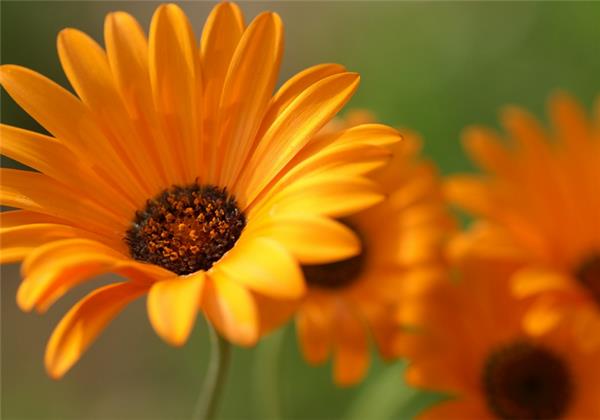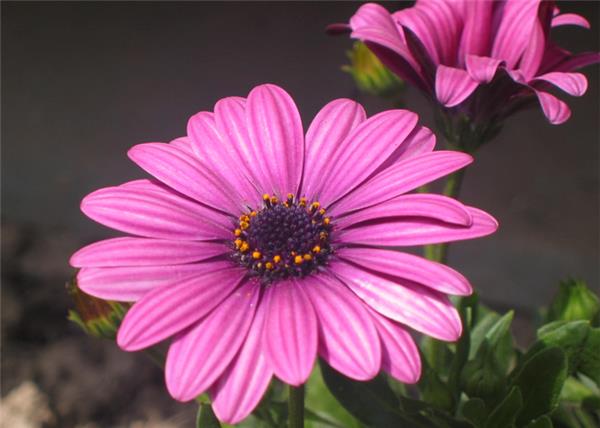Introduction and culture skills of blue-eyed chrysanthemum how to raise beautiful blue-eyed chrysanthemum
Blue-eyed chrysanthemum is colorful, which can be viewed not only as potted flowers on the balcony desk, but also as open-field flowers in early spring and early summer, planting flower beds and flower borders; when planted, it is set off against the strange stones of green grass, which can better reflect its harmonious natural beauty. There are a few creeping varieties that can be cultivated as ground cover plants, so let's take a look at the knowledge of blue-eyed chrysanthemum.

First, the introduction of blue-eyed chrysanthemum
Blue-eyed chrysanthemum is a genus of the family Erigeron breviscapus of Compositae. The blue-eyed chrysanthemum originally belongs to the genus Heterocarpa, from which only one-year-old species are still in the genus, while perennial ones are included in the genus. Blue-eyed chrysanthemum is a close relative of drupe chrysanthemum. The scientific name of blue-eyed chrysanthemum comes from the Greek word for "bone" and the Latin word for "seed". Also known as African daisies, South African daisies, Cape daisies and blue-eyed daisies. There are about 50 species of blue-eyed chrysanthemum, all of which are native to Africa, 35 of which are in southern Africa and Arabia. They are semi-hardy plants, so wild blue-eyed chrysanthemums cannot withstand winter. The alternate leaves of blue-eyed chrysanthemum are green, and some varieties have beautiful markings on their leaves. The leaves are pointed and gun-shaped, and the leaf edges are intact, but the cold-resistant species are serrated.

2. Cultivation techniques of blue-eyed chrysanthemum.
1. Planting
Blue-eyed chrysanthemums like warm and sunny environments and fertile soil. But they can also resist poor soil, high salinity or dry environments. Today's cultivated species have a long flowering period. Proper watering and fertilization can keep the plants blooming without cutting the withered flowers because they are not easy to bear fruit. If you plant in a container, you must prevent the soil from drying up because they will go into dormancy to resist this dry environment. When the plant is dormant, it will cause the buds to fall, and it will not be easy to blossom again in the future. In addition, irrigation after drought, do not irrigate too much water, the soil is too wet roots will be very easy to rot.
The flowers of blue-eyed chrysanthemum are common in the nursery. Propagation is mainly carried out by cuttings and seedlings. Many hybrids and cultivated species have been cultivated. Yellow cultivated species usually have yellow or pale white flowers. One of the most popular blue-eyed chrysanthemums is the wheel chrysanthemum, whose spoon-shaped wing petals are purple to lavender blue with blue discoid flowers. It is an evergreen plant, about 40 meters high. The wing flap will be folded at night or in cold weather.

two。 Points for attention in planting
One of the common diseases is rotten roots, which are mostly caused by too much watering. It can be prevented by properly controlling water and keeping the matrix slightly wet and dry. Once it is found that the root is damaged, the basin should be changed in time and the matrix should be updated. Second, yellow leaves, the causes and control measures of yellow leaves are as follows: ① yellow leaves are mainly young leaves, often with spots (because the pH value of the substrate is too low, resulting in iron poisoning), the pH value of the substrate can be adjusted by pouring appropriate concentration of lime water; the temperature of ② seedling stage is too low, which can appropriately increase the night temperature; insufficient application of ③ nitrogen fertilizer can appropriately increase the amount of nitrogen fertilizer.

Third, the garden use of blue-eyed chrysanthemum
Horticultural development
There are about 50 species of blue-eyed chrysanthemum, all of which are native to Africa, 35 of which are in southern Africa and Arabia. They are semi-hardy plants, so wild blue-eyed chrysanthemums cannot withstand winter. The alternate leaves of blue-eyed chrysanthemum are green, and some varieties have beautiful markings on their leaves. The leaves are pointed and gun-shaped, and the leaf edges are intact, but the cold-resistant species are serrated. Flowers, like daisies, contain tubular and ligulate flowers that grow separately on branches and sometimes in Cymes. Tubular flowers are pseudo-denatured and come in a variety of colors, such as blue, yellow and purple, while cold-resistant species are dark blue in the center. Ligulate flowers have only pistils and have a variety of colors, such as white, milky white, pink, purple, lavender to yellow. Spoon-shaped petals of some cultivated species. Many varieties bloom a second time at the end of summer, while cold-tolerant varieties blossom in spring, but they do not blossom for a second time. It has the characteristics of different flower patterns, colorful flowers, compact and short plant type, florescence lasting for several months and so on. Therefore, as soon as it is discovered, it has attracted the attention of people in the garden circles in Europe and the United States and quickly applied to the garden. Blue-eyed chrysanthemum has been widely used as potted and ground-grown flowers in Europe, the United States and other countries, and many European countries have carried out large-scale commercial production. At the same time, many new varieties were bred through interspecific and intervariety hybridization. Blue-eyed chrysanthemum has several species of semi-shrubs and herbaceous plants, which are also cultivated in 2012 in gardens. Most of the cultivated species of blue-eyed chrysanthemum sold are annual.
The above is the knowledge of blue-eyed chrysanthemum. I hope I can help you.
Blue-eyed chrysanthemum has been widely used as potted and ground-grown flowers in Europe, the United States and other countries, and many European countries have carried out large-scale commercial production. At the same time, many new varieties were bred through interspecific and intervariety hybridization. Blue-eyed chrysanthemum has several species of semi-shrubs and herbaceous plants, which are also cultivated in 2012 in gardens. Most of the cultivated species of blue-eyed chrysanthemum sold are annual.
The above is the knowledge of blue-eyed chrysanthemum. I hope I can help you.
Related
- Wuhan Hospital Iron Tree Blooming Result Was Instantly Frightened by the Gardener Master
- Which variety of camellia is the most fragrant and best? Which one do you like best?
- What is the small blue coat, the breeding methods and matters needing attention of the succulent plant
- Dormancy time and maintenance management of succulent plants during dormancy
- Minas succulent how to raise, Minas succulent plant pictures
- What are the varieties of winter succulent plants
- How to raise succulent plants in twelve rolls? let's take a look at some experience of breeding twelve rolls.
- Attention should be paid to water control for succulent plants during dormant period (winter and summer)
- Watering experience of twelve rolls of succulent plants
- Techniques for fertilizing succulent plants. An article will let you know how to fertilize succulent plants.



